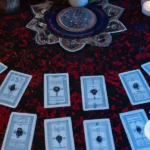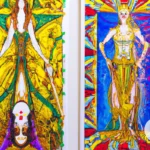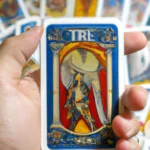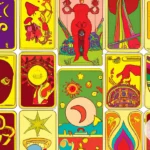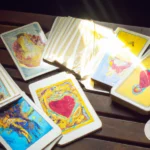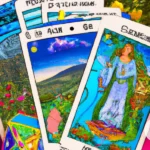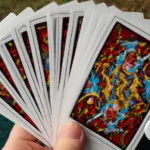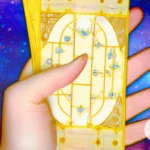Intro
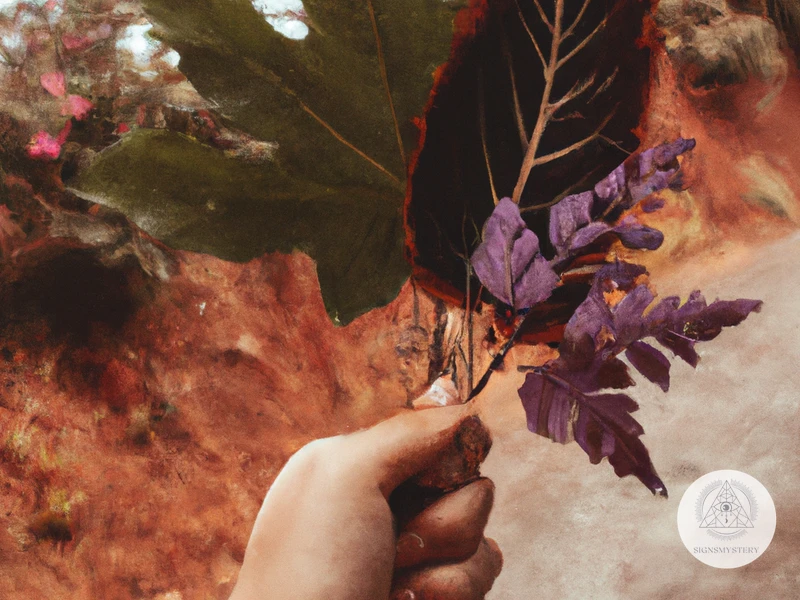
When it comes to tarot readings, the Court Cards can often be the most challenging to interpret. They are unique from the rest of the deck as they depict people instead of abstract concepts or events. However, understanding the Kabbalistic interpretations of these cards can enhance your readings and provide deeper insights into the motivations and personalities of the people involved. In this section, we will explore the Kabbalistic interpretations of the Court Cards, from the Pages to the Kings, and how they relate to the Tarot and Oracle. Before diving into the specific interpretations, it’s essential to understand the relationship between Kabbalah and Tarot, and how this connection can improve your readings. To learn more about Kabbalah’s significance in Tarot, check out our article on Kabbalah and Tarot.
What are the Court Cards?
The Court Cards in a tarot deck are a set of sixteen cards, divided into four categories of four – Pages, Knights, Queens, and Kings. These cards are an essential part of the Minor Arcana suit and are considered to represent people or personalities in the querent’s life. Each of the Court Cards has a unique interpretation, and they can manifest differently depending on the position they appear in a tarot spread.
Understanding the Court Cards can be confusing for those new to tarot, but they provide depth and nuance to a reading. Their symbolism is steeped in Kabbalah, a mystical system that has been integrated into many aspects of western esotericism throughout history. In Kabbalah, the human personality can be broken down into ten different aspects, known as the ten Sephiroth. These aspects are represented on the Tree of Life, a diagram used to understand the workings of the universe and inner workings of the human psyche.
The Court Cards, in particular, are associated with the four Sephiroth of Briah, which relates to the creative world and the realm of the mind. These Sephiroth are:
- Chokmah – Knight
- Binah – Queen
- Tiphareth – King
- Malkuth – Page
The Pages represent the beginning of a journey, and they are often associated with youthful energy, learning, and curiosity. The Knights are the driving force behind action and change, representing the balance between the conscious and the unconscious.
The Queens combine the strength and wisdom of their male counterparts with their intuition and nurturing qualities. Finally, the Kings represent mastery, authority, and being at the peak of one’s power.
By knowing the Kabbalistic interpretations of the Court Cards, tarot readers can gain a better understanding of the personalities they represent and the messages they convey in a reading. These interpretations will help you connect more deeply with the cards and provide further insights into the querent’s life.
Understanding the relationship between Kabbalah and tarot, specifically the correlation between the Major and Minor Arcana cards, can also provide more context and depth to tarot readings. To learn more about this correlation, visit this article on Understanding Major Arcana and Kabbalah or read more about the Tree of Life Tarot Correspondences and Kabbalah Tarot Presence.
Kabbalah and Tarot
The mystical tradition of Kabbalah has been intertwined with Tarot since its earliest days, and the two systems continue to be deeply connected. The study of Kabbalah can provide a profound layer of understanding to your Tarot readings, revealing hidden meanings and shedding new light on the cards. By exploring the ten Sephirot of the Kabbalistic Tree of Life and their corresponding cards in the Tarot, we can unlock a wealth of knowledge about the human psyche and the forces at work in the universe. Let’s delve deeper into the correlations between Kabbalah and Tarot, and see how they can enhance our readings. And if you’re new to the world of Kabbalah, be sure to check out our guide to the ten Sephirot of the Kabbalistic Tree of Life for a comprehensive introduction.
How Kabbalah Can Enhance Your Tarot Readings
The Kabbalah, which is a mystical and esoteric school of thought in Judaism, can have a profound impact on interpreting tarot readings. Here are some ways how:
| Aspect | Description |
| Kabbalah and Tarot | Kabbalah provides a framework for understanding the interconnectedness of all things, which can help Tarot readers find deeper meaning in the cards. |
| Correspondences | The Kabbalah provides a system of correspondences, such as the Four Worlds and the Ten Sefirot, that can be useful in interpreting the Tarot’s symbolism. |
| Intuition | The Kabbalah emphasizes intuition and spiritual knowledge, which can aid Tarot readers in tapping into their own intuition while interpreting the cards. |
| Personal Growth | The Kabbalah is a powerful tool for personal growth and spiritual development, which can be used to enhance the Tarot reading experience for both the reader and the client. |
When used in conjunction with Tarot, the Kabbalah can help readers gain a deeper understanding of the cards and provide more meaningful readings for their clients. By incorporating the Kabbalistic principles of interconnectedness, correspondences, intuition, and personal growth, Tarot readings can become a powerful tool for spiritual development and self-discovery.
Major and Minor Arcana Correlation
The relationship between the Major and Minor Arcana in Tarot has been a topic of inquiry for centuries. The Major Arcana is often referred to as the “trump” cards, while the Minor Arcana is the deck of numbered cards, divided into four suits. Each suit represents a specific element, such as fire, water, air, or earth. The Minor Arcana is further divided into Court Cards and numbered cards, with the Court Cards representing a person or personality.
Understanding the correlation between the Major and Minor Arcana can enhance the accuracy of Tarot readings. Each Court Card in the Minor Arcana represents a specific personality, and these personalities can be linked to a corresponding Major Arcana card. This correlation can give a more complete picture of the person being represented in the reading.
In Kabbalistic interpretations of the Court Cards, each card possesses a specific energy or vibration, which is associated with a specific Sephiroth or sphere on the Tree of Life. The Tree of Life is a diagram in Kabbalistic teachings that represents the universe’s structure and the journey of the soul.
To understand the correlation between the Major and Minor Arcana further, we can look at the following table:
| Court Card | Major Arcana Correspondence |
| :——–: | :————————: |
| Page | The Fool (0) or The Magician (I) |
| Knight | The Chariot (VII) or Strength (VIII) |
| Queen | The Empress (III) or The High Priestess (II) |
| King | The Emperor (IV) or The Hierophant (V) |
The Pages, Knights, Queens, and Kings each have their unique energies and correspondences associated with the Major Arcana. For example, The Page of Wands may represent new beginnings, creativity, and enthusiasm. This aligns with The Fool card in the Major Arcana, which represents the start of a journey and taking risks.
In contrast, The Queen of Swords may represent a sharp mind, clear communication, and objectivity. This aligns with The High Priestess in the Major Arcana, who represents intuition, wisdom, and secrets.
Understanding the correlation between the Major and Minor Arcana can provide further insight into Tarot readings, giving a more holistic interpretation of the cards drawn. With this knowledge, a Tarot reader can provide their clients with a clearer and more profound understanding of their situations.
The Pages
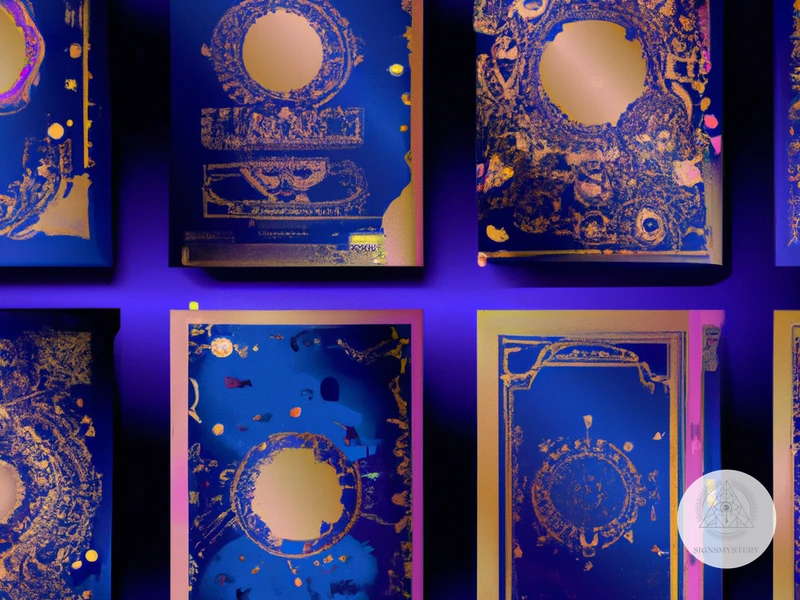
When it comes to the Tarot’s Court Cards, the Pages can sometimes be overlooked or underestimated. However, don’t let their youthful appearance and position as the lowest ranking members of the court fool you. The Pages hold great potential for growth, learning, and exploration. By delving into the Kabbalistic interpretations of each Page, we can unlock a deeper understanding of their messages and gain valuable insights into our own journeys. Let’s take a closer look at each Page and discover what treasures they hold.
Page of Wands
The Page of Wands is one of the 16 court cards in a tarot deck. They represent energy, passion, and creativity. This card is associated with the element of fire and the astrological sign of Aries, Leo, and Sagittarius. In Kabbalistic interpretations of the tarot, the Page of Wands is often seen as a symbol of the beginning of a journey or new project.
Symbolism: The Page of Wands is depicted as a young person holding a wand, which represents creativity and passion. They are also dressed in bright colors, symbolizing the enthusiasm and excitement that come with the beginning of a new journey.
Meaning: When this card appears in a reading, it can indicate that the querent is at the beginning of a new journey or project. They may be feeling excited and passionate about the possibilities that lie ahead. The Page of Wands can also represent creativity and innovation, urging the querent to think outside of the box and take risks. It can be a reminder to pursue your passions and trust your intuition.
Reversed: When the Page of Wands appears reversed in a reading, it can indicate a lack of direction or motivation. The querent may be feeling stuck or uninspired, and struggling to find their creative spark. It may be a sign to take a break and focus on self-care before moving forward. The reversed Page of Wands can also indicate impulsive or reckless behavior, reminding the querent to consider the consequences of their actions.
Below is a table summarizing the symbolism and meanings of the Page of Wands in a tarot reading:
| Symbolism | Meaning | Reversed |
|---|---|---|
| A young person holding a wand | Beginning of a journey or project | Lack of direction or motivation |
| Bright colors | Creativity and passion | Impulsive or reckless behavior |
| Associated with fire and Aries, Leo, and Sagittarius | Pursuing passions and trusting intuition | Need for self-care and thoughtful decision making |
Page of Cups
The Page of Cups represents a young person who is often seen as a messenger of good news. Known for their creativity and emotional depth, this card is associated with water signs (Cancer, Scorpio, Pisces). In Kabbalistic interpretation, the Page of Cups symbolizes the beginning stages of emotional development and the exploration of intuition.
Positive Meanings:
- The Page of Cups indicates a new creative project or artistic venture in the works.
- This card can also symbolize the birth of a new relationship, friendship or romantic.
- It represents emotional vulnerability and an openness to spiritual growth and intuition.
Negative Meanings:
- The Page of Cups can represent emotional immaturity or confusion in decision making.
- If pulled in a negative position, it can imply the querent is not fully in touch with their emotions or is avoiding confronting them.
- It can also represent recklessness, naivety or unrealistic expectations.
In its upright position, the Page of Cups encourages the querent to embrace creativity and emotional expression. In reverse, it calls for introspection and deep reflection on the querent’s feelings and motivations. Understanding the symbolism and Kabbalistic interpretation of the card can enhance a tarot reading and provide clarity for the querent in navigating their emotional journey.
Page of Swords
The Page of Swords in the Tarot is often seen as representing youthful energy and new beginnings. However, when viewed through a Kabbalistic lens, this card takes on deeper significance and meaning.
One important aspect of the Page of Swords is their intellectual curiosity and thirst for knowledge. This is represented in the suit of swords as a whole, which is associated with the element of air and the mind. The Page of Swords is constantly seeking out new information and ideas, eager to expand their understanding of the world around them.
In Kabbalistic terms, the Page of Swords is associated with the sefirah of Hod, which represents intellect, communication, and the power of speech. This sefirah is often thought of as the source of inspiration and divine revelation, and its influence can be felt in the Page of Swords’ razor-sharp wit and quick thinking.
However, Hod is also associated with the shadow side of intellect – arrogance, overthinking, and excessive rationalization. It’s important for the Page of Swords to be mindful of these potential pitfalls and to use their intellectual powers in service of their higher self.
The Page of Swords is a reminder to stay curious, seek out knowledge, and trust in one’s own intellect and intuition. By tapping into the energy of Hod, we can harness the power of communication and self-expression, and find new ways to connect with ourselves and others.
Page of Pentacles
The Page of Pentacles is the embodiment of the earth element, and the zodiac sign of Capricorn. This card often represents a youthful person who is grounded, disciplined, and practical in their approach to life. In Kabbalistic interpretation, the Page of Pentacles is associated with the sefirah of Malkuth, the kingdom, and is seen as a messenger of prosperity and abundance.
Here are some key symbolic associations of the Page of Pentacles to consider during a tarot reading:
- Steadiness: The Page of Pentacles is often depicted holding a pentacle, representing their focus on stability and security.
- Career and finance: The earth element and focus on material goods make the Page of Pentacles a natural fit for questions related to career and finance.
- Responsibility: As a messenger of abundance, the Page of Pentacles also emphasizes the importance of responsibility and hard work in achieving success.
- Learning: The Page suggests a thirst for knowledge and eagerness to learn new skills or take on new challenges.
In a reading, the Page of Pentacles can indicate a message or news related to finances or career growth, but also serves as a reminder to approach opportunities with a grounded and practical mindset. It can represent the need for hard work and responsibility in achieving long-term success, as well as a desire to expand one’s skill set or knowledge in a particular area.
The Knights
As we delve deeper into the court cards in tarot, the next group we encounter are the brave and valiant Knights. Representing action, movement, and change, these cards embody the spirit of adventure and taking risks. The Knights hold a special place in Kabbalistic interpretations of tarot as they embody the sefirot Hod, Netzach, Tiferet, and Yesod respectively. Let’s explore the meaning and significance of each Knight in the tarot deck and discover the hidden wisdom they have to offer.
Knight of Wands
The Knight of Wands in the tarot is often associated with fire and passion. According to Kabbalistic interpretations, this court card is ruled by the sephira Geburah, which represents strength, discipline, and justice. The Knight of Wands is driven by his desire to achieve his goals, and he is not afraid to take risks in order to succeed.
| Aspect | Interpretation |
| — | — |
| Element | Fire |
| Astrology | Sagittarius |
| Kabbalah | Geburah |
| Keywords | Passion, ambition, adventure |
| Description | The Knight of Wands is depicted as a young man riding a horse. He wears armor and carries a wand, which represents his strength and determination. His horse is also decorated with symbols of fire and passion. The Knight of Wands is always on the move, seeking new challenges and adventures. |
This court card can indicate that the querent is taking bold actions towards their goals, or that they need to tap into their passion and drive in order to succeed. The Knight of Wands can also represent a restless or impulsive energy, and it may be important for the querent to temper their actions with discipline and forethought.
The Knight of Wands represents the balance of passion and discipline in achieving one’s goals. By channeling the energy of this card, one can harness their inner fire and take bold steps towards success.
Knight of Cups
The Knight of Cups is associated with water and emotions. In Kabbalistic interpretation, this card represents the aspect of creation known as Briah, which refers to the world of the intellect. The Knight of Cups is a romantic at heart, and represents the idealistic and dreamy side of love and relationships.
Positive Meanings:
- The Knight of Cups can indicate a person who is deeply in touch with their emotions and intuition.
- This card can represent a period of creative inspiration, particularly when it comes to matters of the heart.
- The Knight of Cups may indicate a message or offer of love, romance, or creative inspiration.
Negative Meanings:
- In its negative aspect, the Knight of Cups can represent illusions and unrealistic expectations, particularly in matters of the heart.
- This card can also indicate a lack of emotional maturity or a tendency to be overly emotional and dramatic.
- The Knight of Cups can indicate a person who is unreliable and prone to making promises they can’t keep.
The Knight of Cups represents the importance of following your heart and letting your emotions guide your decisions, while also being mindful of the potential pitfalls of being too idealistic or unrealistic.
Knight of Swords
When the Knight of Swords appears in a tarot reading, it often signifies quick thinking, mental agility and taking action. But how does this archetype fit into the Kabbalistic interpretation of court cards for tarot and oracle? Let’s explore.
| Aspect | Representation |
|---|---|
| Sephiroth | Tiphareth to Yesod |
| Element | Air |
| Direction | East |
| Personality Traits | Determined, focused, cutting, assertive, impulsive, and sharp-witted |
| Mindset | Logical, strategic, and curious |
| Message | A need for clear communication and swift decision making, leaving no room for indecision or second-guessing |
In Kabbalah, the Knight of Swords represents the journey from Tiphareth (the sphere of the Higher Self) to Yesod (the sphere of the subconscious mind). This journey is characterized by the sharpening of the mind, the development of mental discipline, and the acquisition of the ability to make quick and accurate decisions that are based on the clear perception of truth.
The Knight of Swords is associated with the element of Air, which represents the intellect, reason, and the ability to communicate clearly. This is reflected in the personality traits of this archetype: determination, focus, sharpness, assertiveness, impulsivity, and quick-wittedness.
The Knight of Swords can also be impulsive, however, and may act too quickly without considering the consequences of their actions. This can result in conflicts or misjudgments. It is important to temper the Knight’s impulsive nature with logic and strategic thinking.
The Kabbalistic interpretation of the Knight of Swords emphasizes the importance of clear communication, sharp-mindedness, and swift decision making. When this archetype appears in a tarot reading, it may indicate the need for the querent to make a quick decision, to assert their beliefs or to communicate their ideas clearly and decisively.
Knight of Pentacles
The Knight of Pentacles in tarot is known for his patience, diligence, and determination. He is a symbol of practicality and hard work, and is often associated with wealth and financial stability. The Kabbalistic interpretation of this card offers deeper insight into the character and meaning of the Knight of Pentacles.
Symbolism: The Knight of Pentacles is often depicted wearing armor, riding a horse, and holding a pentacle in his hand. The horse represents his unwavering dedication and focus, while the pentacle represents his material wealth and possessions. The armor serves as a symbol of protection against any obstacles or challenges that may arise in his journey.
Kabbalistic Meaning: The Kabbalistic interpretation of the Knight of Pentacles is heavily influenced by the sephirah Malkuth, which represents the physical world and material wealth. At times, the Knight of Pentacles embodies the divine qualities of Malkuth which include practicality, reliability, and prudence. He is a symbol of grounding and patience, which inspires us to be more disciplined and methodical. The Knight of Pentacles reminds us to be diligent in our pursuit of our goals and to take the necessary steps to achieve success.
Personality: Those who exhibit the qualities of the Knight of Pentacles are reliable, hardworking, and practical. They have a strong focus and are not easily distracted which allows them to remain dedicated to their goals. They are patient and have a long-term vision for their future which motivates them to continue on their path even when faced with challenges. The Knight of Pentacles encourages us to stay committed to our goals and be disciplined in our approach.
Divinatory Meaning: In divination, the Knight of Pentacles may represent a message of financial stability, a steady career path, or a practical approach to problem-solving. He may also indicate a need for patience and diligence in achieving one’s goals. Alternatively, he may signify a need to reassess one’s priorities and focus on what is truly important.
The Knight of Pentacles symbolizes practicality, patience, and hard work. He is a reminder to remain diligent and focused in our pursuits while also being grounded and pragmatic. The Kabbalistic interpretation of this card offers a deeper understanding of the symbolism and meaning embedded within the tarot.
The Queens
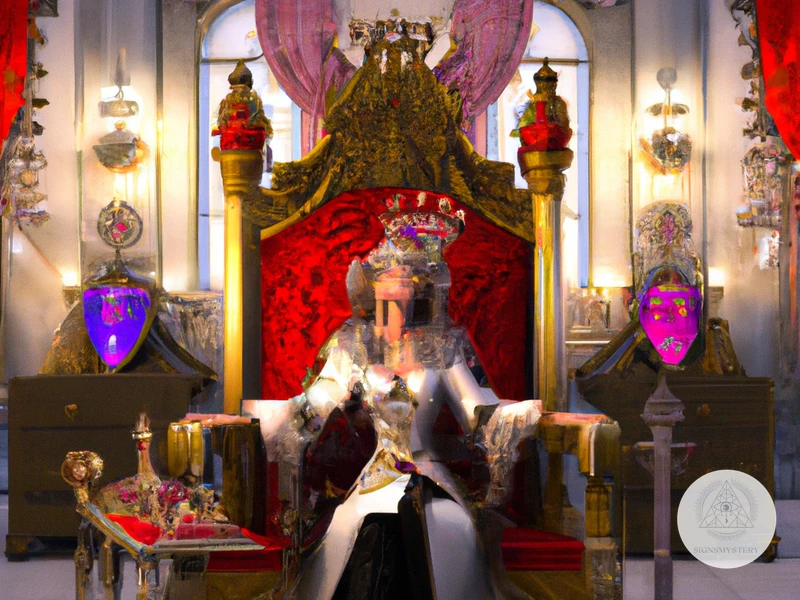
When it comes to the tarot court cards, the queens hold a unique position of power and authority. These regal figures are associated with maturity, wisdom, and grace, and they each bring their own distinctive energy to the table. However, understanding the nuances of each queen can be a challenging task, especially for those who are new to using tarot for divination. So, let’s dive into the mystical world of kabbalistic interpretations and explore the unique characteristics of each of the four queens using detailed analysis and symbolism .
Queen of Wands
The Queen of Wands is a court card that represents fire, passion, and creativity. In Kabbalistic interpretations, she is associated with the element of fire and the sephirah of Hod. Here are some possible interpretations of the Queen of Wands in a tarot or oracle reading:
– The Queen of Wands can represent a woman who embodies the qualities of a leader, a visionary, and a risk-taker. She has a strong will, a magnetic personality, and a quick wit. She is not afraid to speak her mind or to take action, even if it means going against the norm. She can inspire others to follow her lead, and she can ignite their passions with her enthusiasm. She may also symbolize a mother figure or a mentor who nurtures and supports your creative endeavors.
– The Queen of Wands can signal a time of inspiration, creativity, and ambition. You may feel a surge of energy and confidence that propels you forward in your projects or goals. You may have a clear vision of what you want to achieve and how to do it, and you may be willing to take risks or face challenges to make it happen. You may also be more charismatic and influential than usual, attracting others who share your passion and drive. However, be mindful of not becoming too domineering or overbearing, as your enthusiasm may turn into arrogance or aggression.
– The Queen of Wands can also represent a need for balance between your head and your heart. While you may be full of ideas and passion, you may also need to use logic and practicality to make them a reality. You may need to plan, organize, and prioritize your goals, and to be patient and persistent in your actions. You may also need to consider the consequences of your actions and the impact they may have on yourself and others. Remember to stay grounded and humble despite your successes, and to seek the counsel of others who may have different perspectives or skills.
– The Queen of Wands can also have a shadow side, which may manifest as impulsiveness, aggression, or egotism. You may be too focused on your own desires and ambitions, ignoring the needs and feelings of others. You may be too impatient or stubborn to listen to feedback or criticism, and may resent anyone who challenges your authority or vision. You may also be prone to overindulgence in pleasure or power, which can lead to burnout, addiction, or conflict. Beware of falling into these traps, and try to find healthy outlets for your passions and emotions.
The Queen of Wands is a card that invites you to channel your fire and creativity into positive and constructive endeavors. She encourages you to be bold, imaginative, and charismatic, but also to be practical, patient, and humble. She reminds you that your passions are a gift, but that they also come with responsibilities and challenges. If you can balance your head and your heart, and harness your fire
Subscribe to Our Newsletter
Sign up to receive the latest news and updates.
Queen of Cups
The Queen of Cups is a gentle and intuitive card that represents emotional maturity and compassion. In Kabbalistic interpretations, the Queen of Cups is associated with the sephirah of Binah, which represents the divine feminine and encompasses the qualities of understanding, intuition, and insight. Some believe that the Queen of Cups may be further connected to the Shekhinah, the feminine aspect of God in Judaism.
The following are some possible meanings and interpretations of the Queen of Cups based on Kabbalistic symbolism:
– Intuition and Empathy: The Queen of Cups represents emotional depth and sensitivity. This card may signify a need to rely on intuition and empathy to navigate through situations that require understanding and compassion. It could also indicate a time to focus on self-care and emotional healing, as the Queen of Cups encourages us to connect with our inner selves and listen to our hearts.
– Creative Expression: The Queen of Cups is associated with the element of water, which symbolizes emotions, creativity, and spirituality. This card may suggest that artistic or spiritual pursuits could be fulfilling and life-affirming for the querent. It could also indicate a time to explore one’s imagination and connect with the inner child.
– Nurturing and Support: The Queen of Cups represents a nurturing and supportive energy, similar to that of a mother figure. This card may imply a need to provide emotional support to oneself or others, or to seek out such support from those who can offer it. The Queen of Cups encourages us to be kind and compassionate towards ourselves and others, and to create a sense of emotional security in our lives.
– Receptivity and Reflection: The Queen of Cups is associated with reflection and introspection. This card may suggest a time to step back and reflect on one’s emotions, relationships, and spiritual beliefs. It may also imply a need to be open and receptive to new experiences and ideas, allowing oneself to be moved by the flow of life rather than resisting it.
The Queen of Cups is a card that embodies feminine energy, emotional intelligence, and intuitive wisdom. In Kabbalistic interpretations, this card is associated with the powerful female energies of Binah and the Shekhinah, suggesting a deep connection to divine wisdom and understanding. Whether read in isolation or as part of a larger spread, the Queen of Cups can offer guidance and support in matters of the heart and spirit.
Queen of Swords
The Queen of Swords is known for her sharp intellect and her ability to cut through illusions to get to the truth of a matter. She is a figure of great power and authority, but her tendency to be blunt and critical can sometimes put others off. When interpreting this card, it is important to understand the symbolism and imagery associated with it.
| Symbolism | Meaning |
|---|---|
| Sword | The sword is a symbol of mental clarity and the ability to cut through confusion to get to the heart of a matter. |
| Clouds | The clouds in the background represent the Queen’s detachment and her ability to see situations from a higher perspective. |
| Throne | The throne represents the Queen’s authority and her ability to make decisions with confidence and certainty. |
When this card appears in a reading, it may indicate a need for the querent to take a step back and look at the situation from a more objective perspective. The Queen of Swords encourages us to be honest with ourselves and to confront difficult truths, even if they may be painful or uncomfortable. She is a reminder that sometimes the greatest wisdom comes from accepting difficult truths and facing them head-on.
The Queen of Swords is also a symbol of power and authority. She reminds us that sometimes it is necessary to make difficult decisions and to stand up for what we believe in, even if it is unpopular or goes against the consensus. She is a symbol of the strength and resilience that comes from being true to ourselves and our principles.
The Queen of Swords is a complex and multifaceted figure, embodying both the wisdom that comes from confronting difficult truths, as well as the power and authority that comes from being true to oneself. Her presence in a reading can be a powerful reminder of the importance of honesty, clarity, and courage.
Queen of Pentacles
The Queen of Pentacles is a powerful and insightful card in the Tarot deck. She is the embodiment of the element of Earth and is closely tied to all things related to abundance, nurturing, and material wealth. Let’s dive deeper into the Kabbalistic interpretations of this card and what it can mean in a tarot or oracle reading.
Abundance and Prosperity: The Queen of Pentacles represents abundance and prosperity. She may indicate that a period of financial security and stability is on the horizon, or that you have reached a point in your life where you are surrounded by the riches that you have accumulated through hard work, or possibly even inheritance. The Queen encourages you to recognize, appreciate, and celebrate the wealth that surrounds you.
Cultivating and Nurturing: Another key aspect of this card is nurturing. The Queen of Pentacles holds a pentacle in her hands, which represents the material aspects of life that she nurtures with great care. She encourages you to take care of your physical world, including your body, your home, and your community. She also reminds you to cultivate your inner world, nurturing your spiritual and emotional growth.
Groundedness and Practicality: The Queen of Pentacles is grounded in the earth and represents practicality. She encourages you to be grounded in your approach to life, and to focus on the practical aspects of any situation. She also advises you to keep a level head when dealing with finances, and to be practical in your decision-making.
Caring and Compassionate: The Queen of Pentacles is a deeply caring and compassionate card. She encourages you to act with kindness and generosity towards those around you, including family, friends, and even strangers. She reminds you that generosity and compassion can be the keys to unlocking abundance and prosperity.
In a tarot or oracle reading, the Queen of Pentacles can indicate that you are being called upon to nurture and care for yourself, others, or the world around you. She may also signal a new period of financial stability and prosperity is on the horizon, or that now is a good time to focus on practical matters.
The Kings
As we delve deeper into the world of tarot and Kabbalah, we come across another category of cards: the highest ranking in the court cards, the ones that signify authority, power, and control. These cards are represented by the mighty Kings, each with their own unique personality and interpretation. The Kings hold great significance in a reading, as they represent the pinnacle of achievement and mastery in their respective suits. Let us now explore each of the Kings and their symbolic meanings, as we unravel the profound Kabbalistic interpretations of these regal cards.
King of Wands
The King of Wands represents the ultimate expression of fire energy in the tarot. He is the embodiment of creativity, passion, and drive. As a court card, he signifies a strong, influential leader who inspires others through his charisma and vision. Here are some key interpretations of the King of Wands in Kabbalistic tarot:
- Ambition: The King of Wands is a born leader with boundless energy and a powerful desire to achieve his goals. He is not content to sit back and watch things happen; instead, he is always striving to make things happen. He is motivated by his own vision and will stop at nothing to make it a reality.
- Confidence: The King of Wands exudes a sense of self-assuredness that inspires others to follow him. He knows his own worth and is not afraid to assert himself in any situation. His mere presence can be enough to instill faith in his followers and encourage them to take bold action.
- Creativity: As the ultimate fire sign, the King of Wands is a natural innovator who is always coming up with new ideas and pushing the boundaries of what is possible. He is not afraid to take risks in pursuit of his vision and is always looking for ways to break new ground.
- Determination: The King of Wands is a warrior at heart who is driven by a fierce determination to succeed. He is not discouraged by setbacks or obstacles; instead, he sees them as opportunities to learn and grow. His perseverance and resilience are what make him such a force to be reckoned with.
- Inspiration: The King of Wands is a natural born leader who inspires others through his passion and enthusiasm. He has a magnetic personality that draws people to him, and he knows how to harness that energy to motivate his followers toward a common goal. With his charisma and vision, he is capable of achieving great things.
The King of Wands is a powerful figure who represents the pinnacle of leadership and creativity. If he appears in your tarot reading, it may be a sign that you need to tap into your own inner fire and channel your passion and determination toward achieving your goals. With the King of Wands as your guide, nothing is impossible.
King of Cups
The King of Cups in the Tarot is one of the most intriguing court cards, as it represents a balance between emotions and rational thinking. This card has a lot of significance in Kabbalistic interpretations and can reveal a lot about the querent’s emotional state and how they react to situations.
The King of Cups is associated with the element of water, which is linked to emotions and intuition. In the Kabbalah, water represents the subconscious mind and the power of the unknown. This means that the King of Cups is highly intuitive and can sense things that others cannot.
In a Tarot reading, the King of Cups represents a mature and responsible individual who is in control of their emotions. This person may be a mentor or advisor to the querent or could represent the querent themselves in a moment of emotional stability.
King of Cups Keywords: emotional balance, maturity, wisdom, intuition, responsibility.
King of Cups Correspondences:
| Element | Zodiac Signs | Archetype | Hebrew Letter |
| — | — | — | — |
| Water | Scorpio, Pisces, Cancer | Mature and responsible individual | Mem |
As a Scorpio, Pisces, or Cancer, the King of Cups embodies the qualities of an empathic individual, making him the quintessential healer. He is comfortable with his own emotions and can help others navigate their own feelings.
In the Kabbalah, the King of Cups is associated with the Hebrew letter Mem, which symbolizes the waters of creation. This connects the King of Cups to the feminine aspect of creation, intuition, and the subconscious mind.
The King of Cups indicates that the querent should approach situations with emotional maturity and balance. Through his intuition and wisdom, the King of Cups can guide the querent towards making sound decisions that are not only practical but also emotionally fulfilling.
King of Swords
The King of Swords is a card that represents authority, intellect, and communication. In Kabbalistic interpretations, this court card is associated with the sefirah of Gevurah, which represents discipline, judgment, and strength. Let’s take a closer look at the King of Swords and what it means in a Tarot reading.
| Aspect | Interpretation |
|---|---|
| Appearance | The King of Swords is depicted as a mature man sitting on a throne. He is often shown holding a sword or a book, symbolizing his intellect and authority. He is dressed in blue and white robes, representing his clarity of thought and rationality. |
| Personality | The King of Swords is a natural leader and an independent thinker. He is analytical, rational, and logical in his approach to life. He values truth and justice above all else, and will not hesitate to make difficult decisions when necessary. He can be intimidating to some, but his intentions are always good. |
| Love and Relationships | In a Tarot reading, the King of Swords represents a partner who is intelligent, communicative, and rational. He may not be the most emotional or romantic person, but he is loyal and honest. He values clear communication and will not tolerate deception or manipulation. If you are single, this card may indicate that you will meet someone who fits this description. |
| Career and Finances | The King of Swords represents a successful and accomplished career. He is intelligent and analytical, which makes him an excellent problem solver and strategist. He is a natural leader and can make tough decisions when necessary. In terms of finances, this card represents stability and security. |
| Challenges | While the King of Swords is a symbol of intelligence and strength, he can also be cold and detached. He may struggle with expressing his emotions and connecting with others on a deeper level. He may also be too rigid and inflexible in his thinking, which can lead to stubbornness and an unwillingness to consider other perspectives. |
The King of Swords is a card that represents intellect, authority, and communication. It is associated with the sefirah of Gevurah in Kabbalistic interpretations. When this card appears in a Tarot reading, it can indicate a partner who is rational and communicative, a successful career, or stability in finances. However, it can also indicate a need to be more open and flexible in one’s thinking.
King of Pentacles
The King of Pentacles represents the pinnacle of success and stability in the material world. He is the ultimate embodiment of wealth, abundance, and practicality, and he uses these qualities to achieve his goals and ambitions. The King of Pentacles is an influential figure whose strength and ambition inspire others to follow his lead. His energy is grounded and focused, and he is known for his remarkable business acumen and financial success.
In Kabbalistic interpretation, the King of Pentacles is associated with the element of Earth, which represents practicality, stability, and groundedness. Earth is a masculine energy, and the King of Pentacles embodies this energy in its most refined form. He is the ultimate provider and caretaker, using his resources to create a secure environment for himself and those around him.
When the King of Pentacles appears in a tarot reading, it often signifies financial success and stability. It could mean that the querent is on the cusp of a lucrative business venture or that they have already achieved significant financial success. This card is often associated with worldly success and material abundance, but it can also indicate emotional stability and a deep sense of inner fulfillment.
In a tarot reading, the King of Pentacles can also signify a need for practicality, groundedness, and attention to detail. The querent might need to apply their business acumen and resourcefulness to achieve their goals, rather than relying on their intuition or emotions. This card reminds us that success is not just a matter of luck, but rather a result of effective planning, hard work, and dedication.
The King of Pentacles is a powerful card that reminds us of the importance of being grounded and practical in our approach to life. By focusing on our strengths and resources and working diligently towards our goals, we can achieve great success and bring stability and abundance into our lives.
| Keywords | Interpretation |
|---|---|
| Wealth | The King of Pentacles embodies wealth and material abundance. |
| Practicality | The King of Pentacles encourages practicality and attention to detail. |
| Business Acumen | The King of Pentacles is known for his remarkable business skills. |
| Stability | The King of Pentacles represents stability and groundedness. |
| Success | The King of Pentacles often signifies financial success and worldly achievement. |
Conclusion
As we have seen, the Court Cards can offer insightful interpretations and add depth to any tarot reading. By delving into the Kabbalistic influences that shape these cards, we can gain a greater understanding of their meanings and how they relate to our lives.
Through the framework of the Kabbalah, we can see how the Pages represent the youthful and curious aspects of ourselves, while the Knights embody the more active and adventurous parts of our personalities. The Queens reflect our nurturing and intuitive qualities, and the Kings represent the mature and responsible aspects of ourselves.
It is important to note that the Kabbalistic interpretations of the Court Cards are just one perspective, and that personal experiences and intuition should also be considered in any reading. However, by incorporating this knowledge, we can deepen our understanding of the cards and gain new insights into ourselves and the world around us.
Overall, the Court Cards offer a rich and complex tapestry of meanings, and the Kabbalistic influences only add to this complexity. By paying close attention to the details in each card, and embracing the deeper meanings they hold, we can unlock a greater understanding of ourselves and the universe.
Frequently Asked Questions
What is Kabbalistic interpretation of Tarot cards?
Kabbalistic interpretation of Tarot cards involves using the principles of Kabbalah to gain a deeper understanding of the symbols and meanings of the Tarot cards.
What are Court Cards?
Court cards are a part of the Tarot deck that includes kings, queens, knights, and pages. These cards represent different personalities and people in a Tarot reading.
What is Kabbalah?
Kabbalah is a system of Jewish mystical teachings that seek to explain the relationship between God, the universe, and man. Kabbalah is often used as a tool for spiritual growth and understanding.
How can Kabbalah enhance Tarot readings?
By using Kabbalistic principles, a Tarot reader can gain a deeper understanding of the symbols and meanings in the cards. This can help to provide more insightful and accurate readings.
What is the correlation between the Major and Minor Arcana in Tarot?
The Major Arcana cards represent big life events and major shifts. The Minor Arcana cards, including the Court Cards, are more focused on the day-to-day aspects of life.
What is the meaning of the Page of Wands?
The Page of Wands represents creativity, inspiration, and new beginnings. This card encourages taking risks and exploring new opportunities.
What is the meaning of the Knight of Cups?
The Knight of Cups represents emotional intelligence, romance, and creativity. This card encourages following your heart and being true to your feelings.
What is the meaning of the Queen of Swords?
The Queen of Swords represents clarity, logic, and intellect. This card encourages taking a clear-headed approach and making decisions based on reason.
What is the meaning of the King of Pentacles?
The King of Pentacles represents abundance, wealth, and stability. This card encourages taking practical steps to achieve financial success and stability.
How can Court Cards be used in a Tarot reading?
Court Cards can represent people in a person’s life or aspects of their personality. They can also represent situations or events. In a reading, they can provide insight into relationships, emotions, and decision-making.



